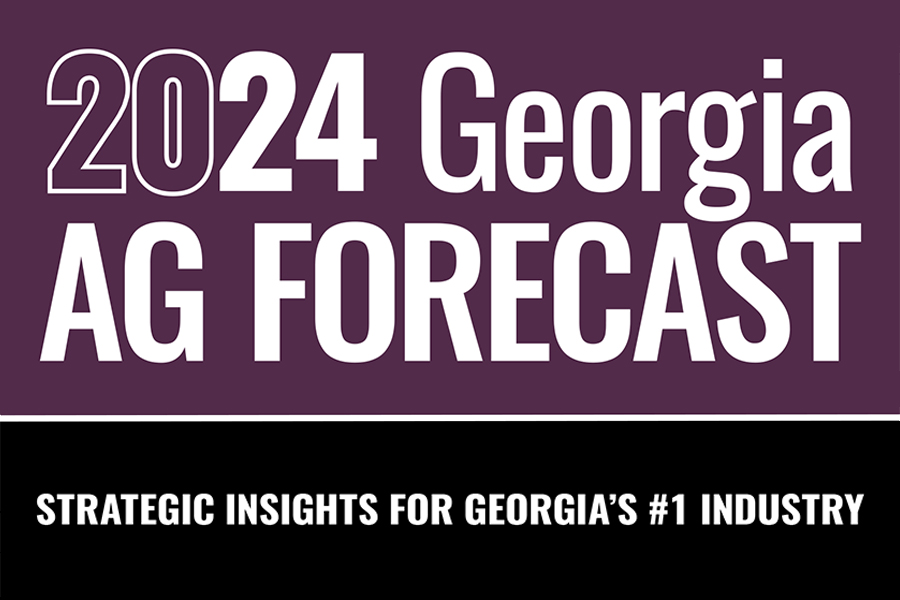Soybeans
-

SB 28-28
Soybean
Commercial insect and weed control in soybeans. Updated annually.
Phillip Marion Roberts, G. David Buntin, Eric P. Prostko, Robert C Kemerait Jr, Allison Faye Johnson, and Michael D Toews
|
-

AP 130-3-09
2025 Corn, Soybean, and Wheat Outlook
1. Tight margins are expected to continue in 2025 for corn, soybeans, and wheat with commodity prices likely near or below the breakeven cost of production.
2. Bountiful grain and oilseed production, combined with a strong U.S. dollar and uncertain trade policy, leads to expectations for lower prices in 2025.
3. Expect more acres planted to corn, fewer acres planted to soybeans, and wheat plantings comparable to last year.Amanda R Smith
|
-

AP 130-2-06
2024 Corn, Soybean, and Wheat Outlook
1. Tighter margins are expected in 2024 for corn, soybeans, and wheat as commodity prices are forecast to be lower and input prices are expected to be flat.
2. Growing demand for sustainable biodiesel fuels will slow soybean price declines relative to the decline in corn prices.
3. Expect more acres planted to soybeans and fewer acres planted to corn and wheat.Amanda R Smith and Ben Campbell
|
-

AP 130-1-06
2023 Corn, Soybean, and Wheat Outlook
1. The Russia-Ukraine war and Mexico’s plan to ban genetically modified corn from the United States will increase uncertainty regarding corn prices. 2. The United States and the world will continue to have a tight wheat supply in 2023, supporting higher than average wheat prices. 3. The low ending stocks of U.S. soybeans indicate the need for more soybeans. Ending stocks might improve in 2023, leading to softer soybean prices.
Amanda R Smith and Yangxuan Liu
|
-

A farm’s return on investment is directly affected by the way water is applied to its crops. The wrong end-gun settings can result in overwatering or underwatering large portions of field acres. Clogged or partially clogged nozzles lead to obvious water shortages that can be visually observed or measured using yield monitors. Systems not properly checked and maintained can lead to significant losses in potential income. This irrigation reference guide will contain information provided by UGA Extension recommended irrigation scheduling rates for corn, cotton, peanuts and soybeans. The guide will also recognize specific center pivot application issues and how to correct them.
David Hall and Wesley Porter
|
-

AP 103-11
Georgia 2019 Soybean Performance Tests
This research report presents the results of the 2019 statewide soybean performance tests. Evaluations were conducted at several or all of the following locations: Tifton, Plains, Midville and Attapulgus in the Coastal Plain region; Griffin and Athens in the Piedmont region; and Calhoun in the Limestone Valley region. For identification of the test site locations, consult the map inside the back cover of this report. The University of Georgia soybean variety trials are conducted under irrigated conditions to minimize variation between years.
Dustin G Dunn, Henry Jordan, and Daniel J Mailhot
|
-

This research report presents the results of the 2017 statewide performance tests of soybean, sorghum grain and silage, and summer annual forages. The tests for various evaluations were conducted at several or all of the following locations: Tifton, Plains, and Midville in the Coastal Plain region; Griffin and Athens in the Piedmont region; and Calhoun in the Limestone Valley region.
Dustin G Dunn, Henry Jordan, and Daniel J Mailhot
|
-

This research report presents the results of the 2018 statewide performance tests of soybean, sorghum grain and silage, and summer annual forages. The tests for various evaluations were conducted at several or all of the following locations: Tifton, Plains, and Midville in the Coastal Plain region; Griffin and Athens in the Piedmont region; and Calhoun in the Limestone Valley region.
Dustin G Dunn, Henry Jordan, and Daniel J Mailhot
|
-

This research report presents the results of the 2016 statewide performance tests of soybean, sorghum grain and silage, and summer annual forages. The tests for various evaluations were conducted at several or all of the following locations: Tifton, Plains, and Midville in the Coastal Plain region; Griffin and Athens in the Piedmont region; and Calhoun in the Limestone Valley region.
The University of Georgia soybean variety trials are irrigated. In addition, dryland soybean variety trials were conducted at four locations (Midville, Plains, Tifton, and Griffin), and irrigated, ultra-late planted soybean variety trials were conducted at Midville and Attapulgus. All are included in this report.
Agronomic information, such as plant height, lodging, and disease occurrence, is listed along with the yield data. Information concerning planting and harvest dates, soil type, and culture and fertilization practices used in each trial is included in footnotes. Since the average yield for several years gives a better indication of a variety’s potential than one year’s data, multiple-year yield summaries have been included.
James LaDon Day, John Gassett, Dustin G Dunn, and Henry Jordan
|